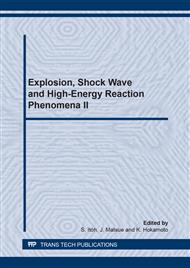p.138
p.144
p.150
p.154
p.160
p.166
p.171
p.177
p.183
Cladding of Titanium and Magnesium Alloy by Explosive Welding Using Underwater Shockwave Technique and Effect on Interface
Abstract:
The wide use of clad joints in practical application has been inhibited due to the difficulty in welding certain combinations such as tungsten/-copper, molybdenum/-copper and magnesium with aluminum, titanium and stainless steel. These material combinations are generally classified as difficult to weld by conventional material joining techniques due to the vast difference in material properties and the degradation of mechanical properties of the joints. Explosive welding is here a viable alternative technique. Explosive welding is a solid-phase welding process that uses the energy of a detonating explosive to create a strong metallurgical bond. This technique has achieved impressive success in the joining of metallurgically incompatible combinations that are otherwise impossible to join by conventional welding techniques. Though the technique is suitable for joining only thin plates, it is efficient in joining some difficult to join combinations like magnesium with aluminum, titanium and stainless steel. In this paper, the result of welding titanium and magnesium was reported.
Info:
Periodical:
Pages:
160-165
Citation:
Online since:
July 2013
Authors:
Keywords:
Price:
Сopyright:
© 2014 Trans Tech Publications Ltd. All Rights Reserved
Share:
Citation:


